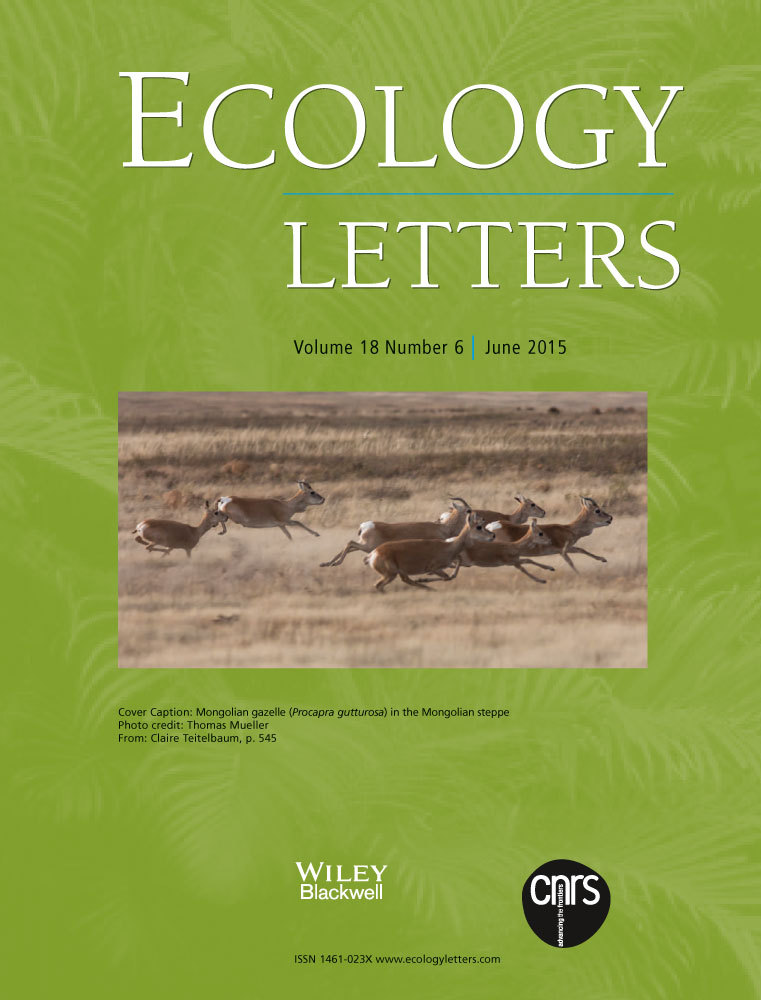How far to go? Determinants of migration distance in land mammals
Abstract
Animal migration is a global phenomenon, but few studies have examined the substantial within- and between-species variation in migration distances. We built a global database of 94 land migrations of large mammalian herbivore populations ranging from 10 to 1638 km. We examined how resource availability, spatial scale of resource variability and body size affect migration distance among populations. Resource availability measured as normalised difference vegetation index had a strong negative effect, predicting a tenfold difference in migration distances between low- and high-resource areas and explaining 23% of the variation in migration distances. We found a weak, positive effect of the spatial scale of resource variability but no effect of body size. Resource-poor environments are known to increase the size of mammalian home ranges and territories. Here, we demonstrate that for migratory populations as well, animals living in resource-poor environments travel farther to fulfil their resource needs.
Introduction
Migratory animals from diverse taxa and geographic locations perform seasonal movements over the course of the annual cycle. The distances they migrate can vary dramatically, even within taxa (Hein et al. 2012), but the drivers that determine how far migratory animals move remain largely unresolved (Milner-Gulland et al. 2011). In range resident animals, numerous theoretical and empirical studies have pointed to the importance of physiological and environmental factors in determining area use (e.g. Kelt & Van Vuren 2001; van Beest et al. 2011). Similar studies of ranging areas of migratory animals are rarer and thus far have examined only physiological determinants (e.g. Hein et al. 2012). Decades ago, researchers postulated that differences in resource needs are a key determinant of the distances that mammals travel during migrations (Heape & Marshall 1931), but this hypothesis has never been explicitly tested.
Here, we focus on ungulates and elephants (hereafter large mammalian herbivores), a group where migration is particularly common and where round-trip migration distances vary from short distances to several thousand kilometres (Berger 2004; Harris et al. 2009). Because both physiology and environmental factors determine ranging areas of range residents, we examine three fundamental categories of potential drivers of migration distance: (1) body size, (2) resource availability and (3) spatiotemporal variability in resource availability.
- Analyses spanning diverse taxa and modes of travel suggest that body size is a key determinant of both migration distance and migration speed (Alerstam et al. 2003; Hein et al. 2012). The positive relationship between body mass and migration distance – where larger animals migrate farther – may occur via metabolic or biomechanical constraints limiting fuel storage or altering the energetic cost of movement (Hein et al. 2012) and applies to dispersal distances and home range sizes as well. Natal dispersal distances among mammals are most strongly correlated with home range area, geographic range size and body mass (Whitmee & Orme 2013). This scaling may be due to the greater energy requirements and motion capacities of larger animals, where increasing the size of their ranging area allows them to access more food (McNab 1963). These allometric relationships appear to explain a considerable portion of the variation in movement distances when comparisons are made across taxa with extreme variation in body size (e.g. rodents vs. elephants; Hein et al. 2012; Whitmee & Orme 2013). However, it remains unknown whether body size helps explain variation in migration distances among large mammalian herbivores, which range from tens to thousands of kilograms.
- On the individual and population levels, variability in migration distances could also be tied to food availability. Most of the literature about the effects of resource abundance on animal movement has focused on ranging areas of range resident animals, where home range size is tied to food resource availability. For example, in several ungulate species, individuals living in low-resource areas increase the size of their home ranges to access the same biomass of food as individuals living in high-resource areas (Saïd et al. 2009; van Beest et al. 2011). Movement rates are also negatively associated with food availability in woodland caribou (Rangifer tarandus) within their home ranges (Avgar et al. 2013). At issue is whether these same operational rules apply to migratory animals as well, thus linking migration distances to resource availability. Food is the most common limiting resource for ungulate populations (Bolger et al. 2008). Consequently, migratory mammals may have to range farther in areas with low resource availability, leading to longer distance migrations in low-resource areas. Though long-hypothesised (Heape & Marshall 1931), evidence for this idea is scarce and no study has examined it across taxa.
- In addition, migration distance may be a response to the spatial scale at which resources change (Alerstam et al. 2003). In a study of four ungulate species across three continents, Mueller et al. (2011) found that migratory species lived in landscapes that varied on a broad scale in a predictable, annual pattern, while resident species lived in landscapes with less variation at broad scales. For moose (Alces alces), this relationship also applies to movement distance, where broad-scale spatial variability in vegetation is associated with long-distance movements and fine-scale spatial variability is associated with shorter distance movements (van Moorter et al. 2013). As the spatial scale of resource variability increases, so does the distance an animal would need to move to reach an area with different resource availability, possibly leading to longer migration distances as animals track food availability across the year.
To date, few studies have examined the link between environment and observed migration distance across multiple species (e.g. Mueller et al. 2011) or multiple populations (e.g. Singh et al. 2012). Moreover, interspecific studies of migration distance have largely focused on the species-specific limits of possible movement or ranging areas (e.g. the maximum migration distance), rather than the actual distance travelled in a particular environment (e.g. Hein et al. 2012). Here, we compiled existing data on migration distances of large mammalian herbivores and examined the relationship between migration distance and environmental and physiological covariates. Departing from past studies, we did not restrict ourselves to predicting the maximum possible migration distance for a particular species nor did we focus on a single potential driver of migration distances. Instead, we explored the relative importance of multiple drivers that influence variation in migration distances among species and populations. In particular, we examined covariates derived from the normalised difference vegetation index (NDVI), which is a measure of vegetation greenness and is widely recognised as a good indicator for resource availability, especially for large mammalian herbivores and on large spatial scales (Hamel et al. 2009; Pettorelli et al. 2011; Ryan et al. 2012). We considered mean annual NDVI as a proxy for general resource availability and the range of the semivariogram of NDVI (Appendix S1) as a proxy for spatial variability in resources. We also accounted for potential differences in migration distance between elevational and non-elevational migrations, because elevational migrations across altitudinal gradients are usually shorter than latitudinal or longitudinal migrations (Levey & Stiles 1992). We expected to see that longer distance migrations would be associated with larger body sizes, landscapes with low-resource levels, high spatiotemporal variability in vegetation and non-elevational migrants.
Methods
Database of large herbivore migrations
We compiled a database on migration distances through a literature search on reports of migrations of large mammalian herbivore populations. We included any reference that described an annual round-trip movement or a within-year movement between non-overlapping locations. By this definition, we distinguished migration from range residency as well as from one-time events such as natal dispersal, but included any long-distance movement, from classical, regular migration to nomadic movements that do not necessarily follow regular patterns (Mueller et al. 2011). We included all suitable references from previously compiled migration databases in Hein et al. (2012) and Harris et al. (2009) and also used Google Scholar and Web of Science to search for any reference of migratory behaviour for all ungulates listed in Ultimate Ungulate (Huffman 2015) and Animal Diversity Web (Myers et al. 2015), using the species name and ‘migration’ as search terms.
We used only those references that provided spatial information on migration routes. To be included, references must have provided mapped locations of the migratory endpoints or physical landmarks of seasonal ranges. Such locations or landmarks allowed us to calculate one-way migration distances using an Azimuthal equidistant projection. Alternatively, a single spatial location was acceptable if the reference also provided a population-specific migration distance. With these constraints, we believe we have compiled the most comprehensive, spatially referenced database of terrestrial large mammal migrations to date.
Explanatory variables
We compiled explanatory variables that relate to the three fundamental categories of potential drivers of migration distance: body size, resource availability and spatiotemporal variability in resource availability. For body mass, we derived species-specific means from the database compiled by Hein et al. (2012) and supplemented missing species from other published literature (Appendix S2); all other variables were environmental covariates based on NDVI.
We used the GIMMS3g NDVI data set (Pinzon & Tucker 2014). The GIMMS3g data set of bi-monthly NDVI composites provides global coverage at a spatial resolution of 8 × 8 km. For our analyses, we used the 672 composites for the 29-year period 1982–2010. We (1) rescaled the data to the original floating-point NDVI scaling of [−1,1], (2) identified and removed falsely included water pixels with a correction layer based on vector layers of continental coastline, lakes and reservoirs (Natural Earth 2014) and (3) applied a minimum threshold that set all pixels with NDVI values < 0.05 to 0.05. NDVI values below 0.05 indicate non-vegetated areas (e.g. bare soil, water, snow and ice) and therefore would not reflect resource quantity for ungulates. This 0.05 threshold is based on an analysis of stable pixels in the Sahara Desert that had an average NDVI of 0.094 and has been used previously in studies examining trends in NDVI (e.g. Slayback et al. 2003).
As a proxy for the average resource quantity in a given migration landscape, we extracted values for mean annual NDVI across the period 1982–2010 at the mid-point of each migration.

In addition to the explanatory variables related to body mass and environment, we also accounted for the elevational status of migrations. To categorise migrants as elevational or non-elevational, we calculated an index that related the distance moved to elevation gained during the migration and easily distinguished between elevational and non-elevational migrations (for details see Appendix S3). For the five migrations for which we had only one point on the migration route, we categorised migrants as elevational or non-elevational based on the literature sources used to build the database.
Data analyses
We built a linear mixed-effects model with the library lme4 (Bates et al. 2014) in R (R Core Team 2014) using log-likelihood estimates to determine which covariates have an effect on migration distance. We log-transformed body mass and the spatial range of the NDVI semivariogram (Hein et al. 2012; Whitmee & Orme 2013). We verified that the relationship between migration distance and each covariate was linear using a lowess smoothing function (panel.smooth in R; Appendix S4). The model tested log-transformed migration distance as the response variable and included study and species identifiers as random intercepts. In this study we report both P-values and ΔAICs (Murtaugh 2014). T-test and P-value estimation were done with functions of the library lmerTest that uses the Satterthwaite approximation to estimate denominator degrees of freedom for random effects models (Kuznetsova et al. 2014). We evaluated the relevance of each predictor variable by calculating the ΔAIC of the full model vs. the model without the focal predictor (Burnham & Anderson 2002). We calculated partial residuals using methods described in Ryan (2011) as well as conditional and marginal R2 values for the full model using methods described in Nakagawa & Schielzeth (2013). We also calculated an alternative model that, instead of using species as a random intercept, incorporated a phylogenetic tree (Appendix S5). This model used Markov Chain Monte Carlo methods instead of log-likelihood to estimate parameters and produced indistinguishable results from the model described here.
Results
The literature search resulted in a spatially referenced database of 94 migrating populations representing 25 large mammalian herbivore species (Fig. 1). Migration distances ranged from 10 to 1638 km (Fig. 2) and species' body masses ranged from 19 to 3900 kg (Appendix S2).
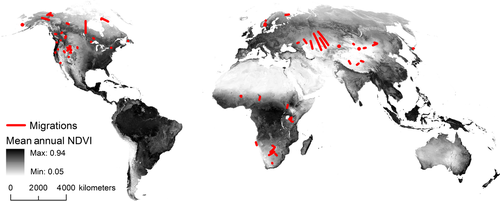
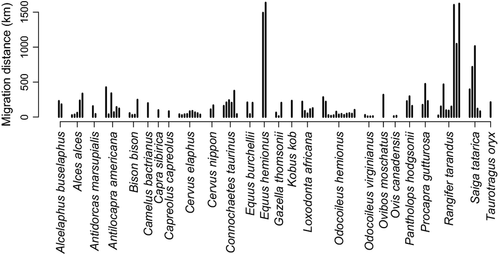
Relationship with environmental variables and body mass
The full model with resource availability, spatial variability in resource availability, body mass and elevational status explained 31% of the variation in migration distances (marginal R2 = 0.314), with resource availability and spatial variability both having significant effects (Table 1; Fig. 3). When considering the random effects of species and study as well, the full model explained 88% of the variability in migration distances (conditional R2 = 0.885).
| Coefficient | Lower 95% CI | Upper 95% CI | P | ∆AIC | |
|---|---|---|---|---|---|
| Mean annual NDVI | −1.333 | −1.879 | −0.786 | <0.001 | −15.231 |
| Range of NDVI semivariogram (km) | 0.353 | 0.073 | 0.634 | 0.015 | −3.127 |
| Body mass (kg) | −0.064 | −0.255 | 0.127 | 0.517 | 1.592 |
| Elevational | −0.209 | −0.412 | −0.006 | 0.052 | −1.834 |
- Migration distance, the range of the normalised difference vegetation index (NDVI) semivariogram, and body mass were log transformed. The model also incorporated a study identifier and species as random intercepts. ∆AIC values were calculated by subtracting the AIC of a reduced model containing all fixed effects except the focal covariate from the AIC of the full model.
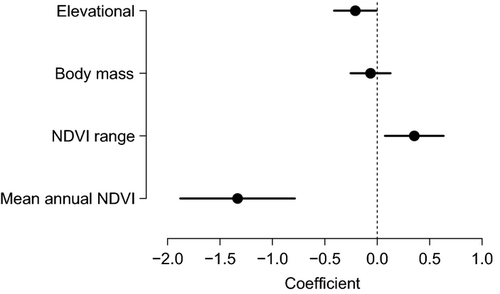
Resource availability, measured as mean annual NDVI, explained the largest amount of variability in migration distance. Removing NDVI from the model increased the AIC by 15.231 (Table 1) and calculating the marginal R2 value without NDVI reduced the value from 0.314 to 0.085, indicating that mean NDVI alone explained at least 23% of the variation in migration distance. When we accounted for study, species and all additional fixed effects, a partial residual analysis revealed a strong relationship between NDVI and migration distance (Fig. 4; R2 = 0.852). The relationship between NDVI and migration distance was negative (Table 1; Fig. 3); when all other variables were held constant, animals living in regions that exhibited low vegetation greenness (i.e. mean annual NDVI c. 0.06) had a predicted migration distance of 206 km and animals in regions with relatively high vegetation greenness (i.e. mean annual NDVI c. 0.80) had a predicted migration distance roughly one-tenth as large (21 km; Fig. 5).
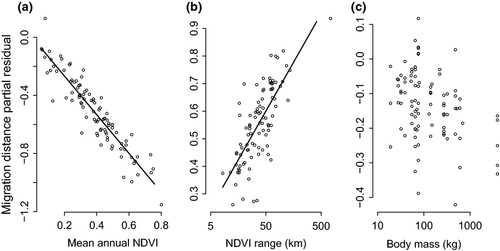
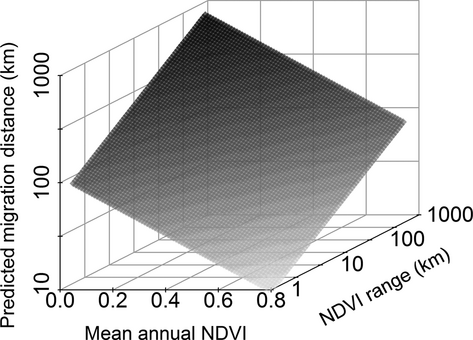
The relationship between migration distance and spatial variability in resource availability, measured as the spatial range of the NDVI semivariogram, was significant and positive, indicating that longer migrations occur in environments where vegetation varies on a broader spatial scale (Table 1; Fig. 5). Removing the spatial range of the NDVI semivariogram from the model increased the AIC by 3.127 and calculating the marginal R2 value without the spatial range of the NDVI semivariogram decreased the value from 0.314 to 0.276, meaning that spatial variability in resource availability explained only 3.7% of the variation in migration distance. There was no relationship between body mass and migration distance and only a marginally significant effect for elevational status wherein elevational migrants may move shorter distances than comparable non-elevational migrants (Table 1; Fig. 3).
Discussion
Using a spatially referenced database of mammalian land migrations, we found that environments with low-resource availability and broad spatial scales of resource variability were associated with longer migration distances. Mean annual NDVI had the strongest relationship with migration distance; animals in resource-poor landscapes migrated almost 10 times farther than animals in resource-rich landscapes, indicating that resource availability strongly determines migration distance in large mammalian herbivores. Studies of range residents support a decrease in ranging areas with increasing resource availability, where the negative relationship between resource availability and home range size is well documented across taxa. This relationship holds regardless of whether NDVI or other measures of resource availability are being used. For example, home range sizes of turkey vultures can be approximated with NDVI (Dodge et al. 2014), whereas home range sizes of capybaras are negatively related to estimates of food availability based on ground surveys (Corriale et al. 2013). The link between ranging area and resource availability is particularly well documented for ungulates, where increasing home range size often directly relates to increases in the quantity of resources an individual can access (e.g. Saïd et al. 2009; van Beest et al. 2011; Morellet et al. 2013). Our results document an analogous relationship between migration distance and resources on larger spatial and taxonomic scales.
In this study, we compared migration distances across populations, using one reported distance per migratory population and linking this distance to general landscape patterns. Complementary to our work, other studies have analysed relocation data of individual animals within single migratory populations, linking particular movement behaviours to resource conditions at the time of movement. These population- and individual-level studies have found evidence for longer migratory movements under resource-poor conditions. In a study of GPS-tracked caribou, Avgar et al. (2013) found that high forage availability and quality suppressed movement distances on both monthly and hourly scales. Mechanistically, the authors suggest that their result reflects foraging behaviour, where animals remain more stationary in high-resource areas and movements are triggered by decreasing resources; this hypothesis is further supported by Bartlam-Brooks et al.'s (2013) study of zebra (Equus burchelli), who found that animals migrated more slowly at times when NDVI values were high and timed their migrations so they would reach their final destination just prior to peak vegetation greenness. On the population level, there is evidence for a connection between interannual variability in resources and migration patterns. For example, Mongolian gazelle (Procapra gutturosa) populations ranged farther than usual when resource levels were low (Ito et al. 2013). These species- and population-specific studies show a decrease in movement with increasing resource availability on fine scales, analogous to the results of this study's landscape-scale and across-population comparison.
We also saw a positive albeit slight trend in the relationship between the spatial range of the NDVI semivariogram and migration distance, suggesting that animals living in environments that vary on a broader spatial scale migrate longer distances. Theory suggests that landscape variability drives the evolution of migratory behaviour (Morales et al. 2005) and some empirical studies show a link between variability in resources and animal movements (Mueller et al. 2011; van Moorter et al. 2013). We found a trend of increasing migration distances with an increasing scale of variability in vegetation (Figs 3 and 4). Though this effect has not been well studied across species, van Moorter et al. (2013) showed that the distance moved by individual moose depended on the spatial scale of resource variability. Spatial variability in resources explained the variation in movement distances both between individuals and for single individuals across time. In our study, we detected this same relationship across populations. However, we found that the effect of spatial variability in resources was smaller than the effect of absolute resource availability, indicating that the main driver of migration distances in large mammalian herbivores is resource availability.
Previous studies have reported allometric scaling relationships for natal dispersal distances (Whitmee & Orme 2013; Stevens et al. 2014) and home range sizes (McNab 1963) as well as for maximum migration distances (Hein et al. 2012). We found no allometric relationship when considering variation in migration distance among populations of large mammalian herbivores (which still spanned 2.3 orders of magnitude in body size). In our study we did not include very small mammals such as the rodents, lagomorphs and carnivores included by Hein et al. (2012) and a weakening of allometric scaling relationships when considering different or smaller spatial or taxonomic scales is not unusual (White et al. 2007). Our results are also supported by Berger's (2004) study of migratory species, which showed that body mass did not explain migration distance in a subset of large migratory mammals. In addition, our measure of body mass was species specific and did not resolve on the population level, and thus could not possibly explain any variation among populations of the same species. However, we emphasise that in general, interspecific variation in body mass is much greater than the variation that may be present among populations of the same species.
Resource availability and the spatial scale of resource variability together explained 27% of the variance in migration distances. The substantial remaining variation in migration distance was either accounted for by the random effects in our model (57%) or not accounted for at all. This remaining variation could be due to a number of factors not addressed in this study. First, because our data are compiled from literature sources, our estimates of migration distances and locations could be affected by the accuracy or precision of the original source as well as by historical effects, including changes in migration routes since the time of publication. Furthermore, we could not test some potential drivers of migration, such as predator avoidance. Finally, we used NDVI as a proxy for resource availability. On the broad spatial scales relevant for this study, NDVI is an excellent measure of resources for ungulates (Pettorelli et al. 2006; Hamel et al. 2009) as well as an extremely useful predictor for movements (van Beest et al. 2011; Pettorelli et al. 2011). However, at finer scales, NDVI can be problematic as a measure for herbivore resources because it may not adequately reflect quality/quantity tradeoffs related to forage maturation (Mueller et al. 2008) and may over- or underestimate resource availability because of confounding effects related to snow and/or canopy cover (Sawyer et al. 2005; Pettorelli et al. 2006; Wilcove & Wikelski 2008). Still, many of these limitations manifest only at small spatial scales and within the same system or affect minimum or maximum NDVI values. Averaged across years and used for broad scale and across-systems comparisons as done in this study, NDVI is a powerful measure of resource availability for herbivores (Pettorelli et al. 2006, 2011; Hamel et al. 2009; van Beest et al. 2011).
Understanding the drivers of animal migrations is particularly important because climate change and human development are modifying natural landscapes. Migratory animals are especially susceptible to these modifications because they have such large area requirements, meaning that anthropogenic landscape changes are likely to affect at least some areas through (or to) which these animals migrate (Berger 2004; Bolger et al. 2008; Wilcove & Wikelski 2008). Herbivores that do not adjust to the spatial and temporal changes in plant phenology due to global climate change experience reduced fitness (Post et al. 2008). The significant relationship between resource availability and migration distance highlights the importance of adaptive movement on large spatiotemporal scales. Accordingly, the link between resource availability and migration distance suggests that the significant long-term changes of NDVI in many regions of the globe (Fensholt & Proud 2012) may force animals to alter the distance and timing of their migrations.
Acknowledgements
WFF, CHF, JMC, PL and TM were supported by NSF ABI award 1062411. CHF was supported by a Smithsonian Institution Postdoctoral Fellowship. CST and TM were supported by the Robert Bosch Foundation. We thank M.A. Tucker and R.B. O'Hara for their helpful input on the manuscript and analysis.
Authorship
CST, WFF and TM conceptualised the study and wrote the first draft; CST, GD, CHF and TM built the database and performed analyses; CST, WFF, CHF, GD, JMC, PL and TM contributed to writing the final paper.



